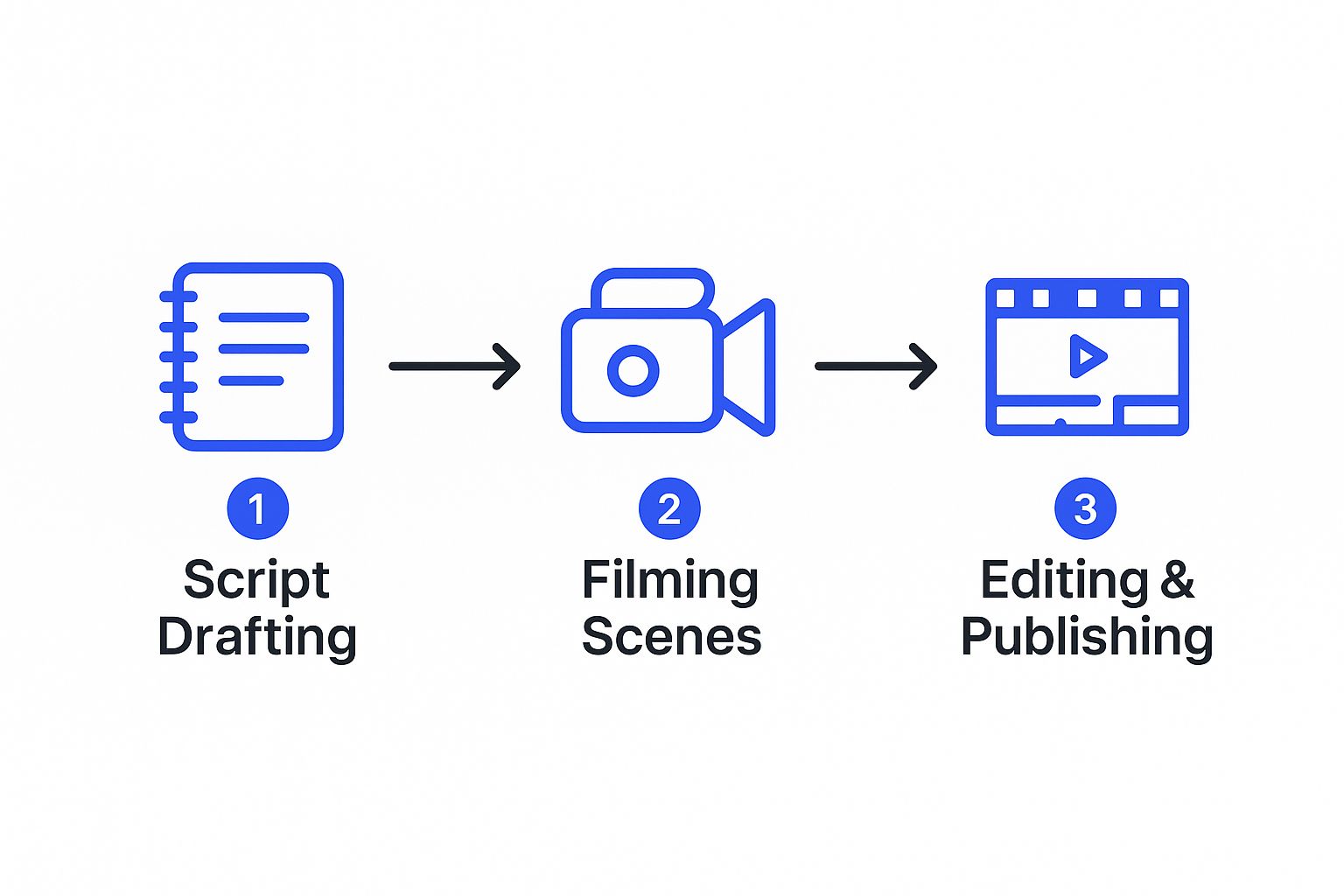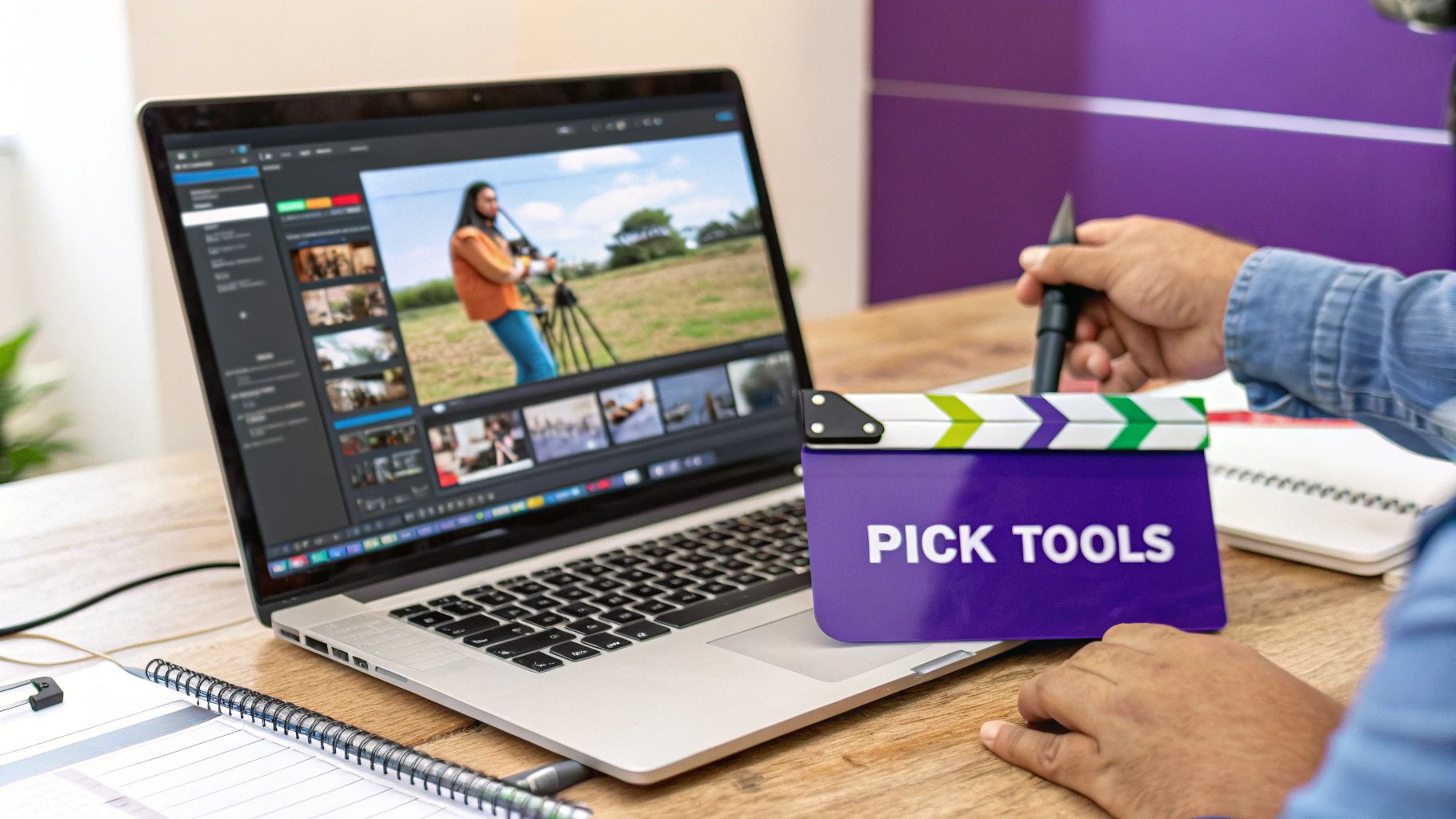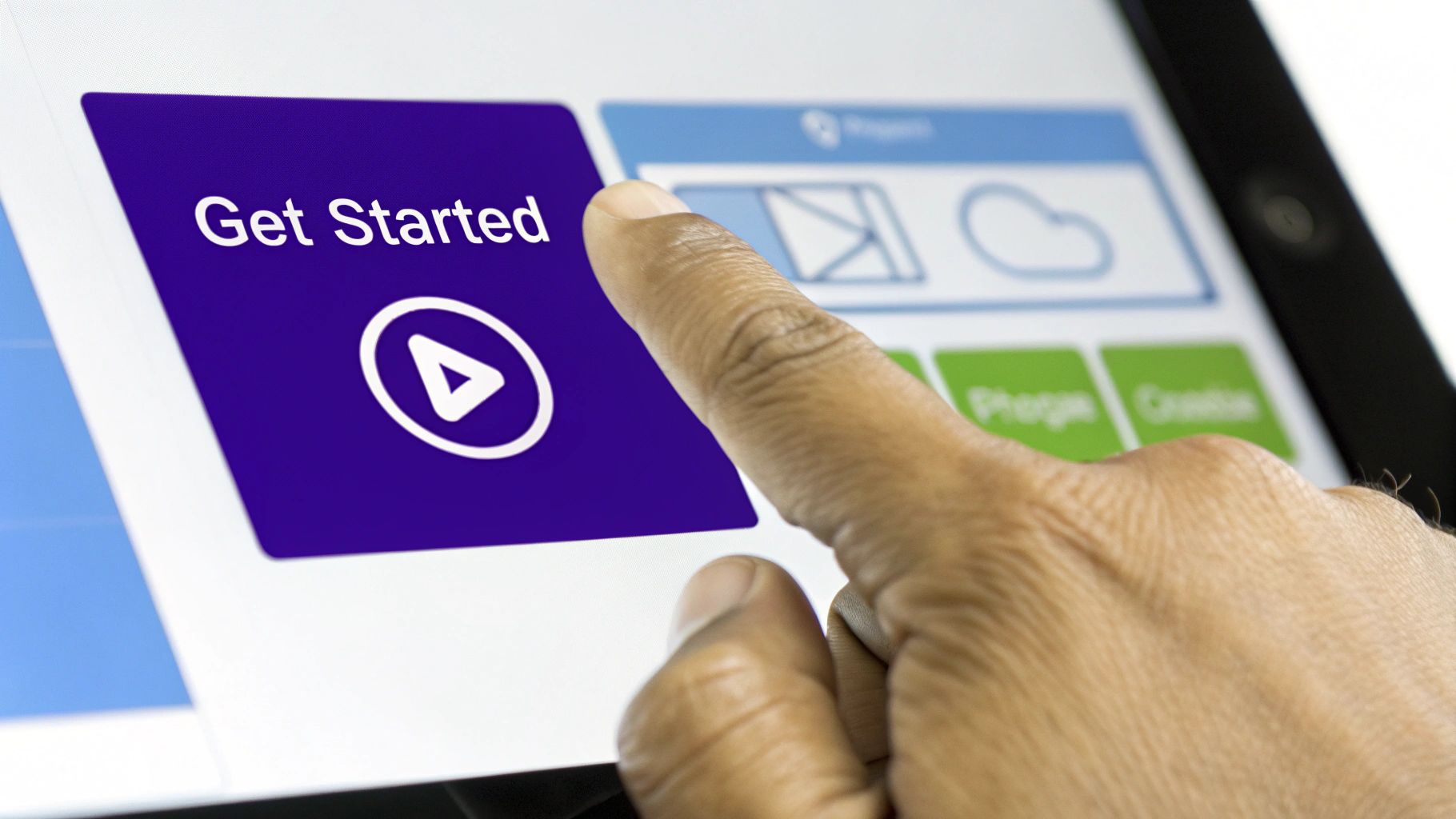Create a Powerful Client Testimonials Video
Learn how to create a compelling client testimonials video that builds trust and drives conversions. Get expert tips and strategies for success.
Posted by
A client testimonial video is pretty straightforward: it’s a short film featuring a happy customer talking about their great experience with your brand. But don't let the simplicity fool you. These videos are marketing gold.
Unlike a slick ad, a testimonial builds trust by showing a real person who solved a real problem with your help. It’s your most powerful form of social proof in action.
Why Client Testimonial Videos Are Essential for Growth
Let's be real—modern buyers have their guards up. They're tired of being sold to and have gotten incredibly good at tuning out traditional marketing messages. Instead, they're looking for genuine recommendations from people they can actually relate to.
This is where a well-made testimonial video cuts through all that noise. It offers an authentic voice that connects with potential customers on a human level.
Seeing and hearing a real person share their success story creates an emotional spark that a written review just can't replicate. It’s one thing to read a five-star rating; it’s another to watch someone’s face light up as they explain how you solved their biggest headache. That human element is everything.
The Psychology of Authentic Endorsements
The magic behind these videos is rooted in a core psychological principle: social proof. When we're unsure about a decision, we instinctively look to others to see what they're doing. A video testimonial provides that clear, undeniable evidence that other people have chosen your brand and are thrilled they did.
This format transforms a generic marketing claim into a believable story. Instead of just saying your product saves time, a testimonial shows a real business owner explaining how they got 10 hours back each week to focus on growing their company.
"When you say it, it’s marketing. When your customers say it, it’s evidence. Video testimonials in particular are an effective way to build trust with buyers." - Sam Shepler, CEO at Testimonial Hero
Driving Tangible Business Results
This isn't just a trend; it's a proven strategy that drives real growth. The numbers don't lie. Recent data shows that a whopping 87% of businesses now use video testimonials—that's a 21% jump in just the last two years.
Even more telling, 92% of consumers say they trust video testimonials more than traditional ads. That kind of credibility is priceless.
To really get a sense of its value, look into the impact of corporate videography on a company's bottom line. Each video you create is another powerful asset for your brand, turning your happiest customers into your most effective sales team.
Finding and Preparing Your Best Advocates

Let's get one thing straight: the magic of a great client testimonial video isn't about fancy cameras or slick editing. It’s about a fantastic story from a genuinely happy customer.
But here’s the thing—not every happy client is the right person to put on camera. You’re looking for true advocates. These are the people who not only love what you do but can actually explain why it’s so valuable in a way that clicks with others.
Start by thinking about customers who’ve had real, measurable wins. Maybe they're long-term partners who have grown with you, or someone who just sent an amazing email to your support team. Look for the people who are already engaged.
Identifying Potential Stars
So, who makes the perfect person for a testimonial video? I always look for a few key traits:
- Genuine Enthusiasm: These are your power users. They’ve given you a great review before or had a glowing conversation with your team. They just get it.
- Clear Communicators: Can they explain their problems and how you solved them without getting lost in jargon? Someone who is naturally articulate is going to shine.
- Relatable Stories: This is huge. Their situation should sound familiar to your ideal customer. When a prospect sees themselves in the testimonial, you've struck gold.
Once you’ve got a shortlist, it’s time to reach out. This first conversation is everything. Don't make it sound like you're asking for a huge favor. Instead, frame it as a chance to feature their success story and make them the hero. It instantly shifts the dynamic from a chore to a cool opportunity.
We've got a whole playbook on this, by the way. If you want to master the art of the ask, check out our guide on how to ask for a testimonial.
Crafting Questions That Uncover a Story
Your interview questions are probably the most critical part of this whole process. Forget simple yes/no questions. You need prompts that get people talking and telling a story.
A question like, "Do you like our product?" is a dead end. You'll get a "yes," and that's it. Useless.
Instead, your questions need to pull out the specifics of their journey—the before, the during, and the after.
Key Takeaway: The best testimonials follow a classic story arc. They start with a problem, introduce your product as the guide or solution, and end with a clear, positive result. Your job is to ask the questions that build this arc.
Here’s a simple framework I use to structure my interview questions:
- The "Before" Picture: Get them to paint a picture of the struggle. What were their biggest frustrations before they found you? What did a day in the life look like? You want the audience to feel that pain.
- The Discovery: How did they come across your solution? What else were they considering? This is crucial for understanding why they chose you over the competition.
- The "After" Transformation: Now we get to the good stuff—the results. Ask for numbers, metrics, or tangible changes. How is their business different now? What can they do today that was impossible before?
When you focus on these narrative pillars, you get so much more than a flat endorsement. You get an authentic story of transformation that truly connects with the people you’re trying to reach.
Recording High-Quality Video Without a Hollywood Budget
Let's be clear: you don't need a massive budget or a full-on production studio to create a client testimonials video that works. In fact, some of the most powerful testimonials feel raw and authentic, not slick and overproduced.
You can get a seriously high-quality look with gear you probably already have. The secret isn’t spending a fortune on a fancy camera; it’s about nailing three simple things: lighting, sound, and background. A modern smartphone shoots incredible video, but if the lighting is dark and the audio is a muffled mess, the whole thing just falls apart.
For lighting, forget complex setups. Just position your client facing a large window. That soft, natural light is incredibly flattering and costs nothing. If you're stuck without a good window, a simple ring light is a game-changer. It provides even, clean light and gets rid of those harsh, distracting shadows.
Mastering Crystal-Clear Audio
Here’s a hard truth: viewers will forgive slightly grainy video, but bad audio is an instant dealbreaker. It’s non-negotiable.
The built-in microphone on a phone or laptop is your enemy. It picks up everything—the air conditioning, the echo in the room, the dog barking down the street. It makes your client sound distant and unprofessional. This is the one area where a small investment pays off big time.
An external microphone is the answer. You've got a couple of great, affordable options:
- Lavalier Mics: These are the little clip-on mics you see on news reporters. They're fantastic because they attach right to a shirt, isolating the person's voice and cutting out almost all the background noise.
- Shotgun Mics: These are more directional. You can mount one on your camera to capture sound from directly in front of you while minimizing noise from the sides.
If you're looking for the right gear, there are plenty of guides that break down the best microphone for video recording for any budget.
The image below gives you a bird's-eye view of the entire testimonial production process.

As you can see, the actual filming is just one piece of the puzzle. The real magic happens with smart planning before and skilled editing after.
Setting the Scene and Directing with Confidence
The environment you film in matters just as much as your equipment. Find a spot that’s quiet and visually simple. A clean office, a wall with some subtle branding, or even a tidy living room works perfectly. The goal is to keep the focus entirely on your client and their story—no distracting clutter in the background.
When the camera starts rolling, your job instantly changes from technician to director. Most people are not naturally comfortable on camera. Your main goal is to make them feel relaxed.
Don't hand them a script to memorize. That’s a recipe for a wooden, awkward performance. Instead, just have a genuine conversation using those open-ended questions we talked about earlier. Your calm, encouraging vibe will help them forget the camera is even there and just speak from the heart.
The difference in quality is staggering. People remember 95% of a message when they see it in a video, compared to only 10% when reading it in text. And since 91% of consumers say video quality impacts their trust in a brand, getting these technical details right is crucial for building credibility.
Navigating the technical side of recording can be a hurdle for both you and your client. Deciding between a DIY in-person shoot and a streamlined remote recording involves different gear and considerations.
Remote vs In-Person Recording Setup Comparison
| Element | Remote Recording (e.g., via EndorseFlow) | In-Person Recording (DIY) |
|---|---|---|
| Camera | Client's built-in webcam or smartphone | DSLR, mirrorless, or high-quality smartphone |
| Microphone | Client's headset or computer mic (platform can guide them) | External lavalier or shotgun mic |
| Lighting | Relies on client's natural light (e.g., facing a window) | Ring light, softbox, or 3-point lighting kit |
| Background | Client's home or office space (often uncontrolled) | Controlled, branded, or simple professional backdrop |
| Direction | Provided remotely through prompts and live guidance | In-person direction and coaching |
| Key Advantage | Extreme convenience for the client; no travel needed | Complete control over audio, video, and lighting quality |
While in-person shoots offer maximum control, remote recording platforms dramatically lower the barrier to entry, making it far easier for busy clients to participate.
Pro Tip: For remote recordings, platforms can completely simplify the technical side for your client. To learn more, check out our guide on choosing the best video testimonial software to handle the recording process for you.
Editing Your Footage Into a Compelling Story

Alright, the recordings are done. Now comes the fun part: turning all that raw footage into a story that actually resonates. What you have is pure potential—a collection of authentic moments and powerful soundbites just waiting to be shaped. This is where the magic really happens. Post-production is how you build emotional momentum and make sure every single second works hard for your brand.
First thing’s first: you need to sift through everything you’ve got to find the absolute best moments. This isn't just about grabbing the clearest answers to your questions. You're hunting for the clips where your client's personality just pops.
Look for the unscripted laugh, the thoughtful pause before a big statement, or that one killer line that perfectly sums up their experience. This is the gold.
Once you’ve pulled out these gems, you can start thinking about the overall structure. The most powerful testimonials almost always follow a classic story arc: they start with a relatable problem, introduce your business as the guide or solution, and end with a celebration of the result.
Assembling a Cohesive Narrative
With your best clips selected, it's time to start weaving them together. The goal here is to create a narrative that feels natural and keeps people watching. A great starting point is to lay out a rough cut that follows that problem-solution-result framework.
Don't even think about perfection at this stage. Seriously. Just get the main interview clips onto your timeline to see how the story flows. This is your chance to chop out all the filler—the "ums," "ahs," and repetitive phrases—to make the interview sound tight, confident, and professional.
Key Insight: A testimonial video shouldn't just list features; it should tell a story of transformation. Structure your edit to show the journey from the client's initial pain point to their ultimate success, making the emotional impact the focal point.
After you've tightened up the core interview, it’s time to bring in the visuals that give it life. This is where your b-roll comes in, and it’s absolutely crucial.
- Show, Don't Just Tell: When your client talks about a specific benefit, cut away from them to show your product or service in action. If they’re talking about how much time they saved, show them breezing through the task that used to be a headache.
- Emphasize Key Points: Use clean, simple text on screen to highlight a powerful quote or a jaw-dropping statistic. Did they mention a 40% increase in efficiency? Put that number on the screen. It makes the claim stick.
- Set the Mood: Find some subtle, uplifting background music that matches the video's tone but doesn't overpower the speaker. The right track can amplify the emotion without distracting from the message.
Finally, polish it off with your branding. Add your logo at the beginning and a clear call-to-action at the end. With tools like EndorseFlow simplifying everything from collection to editing, creating a persuasive testimonial that actually drives results has never been easier.
Promoting Your Video for Maximum Impact
You’ve done it. You have a brilliant, authentic client testimonial video in hand. That’s a huge win, but it’s only half the battle.
A powerful video that nobody sees is like a silent sales pitch. To get a real return on your investment, you need a smart plan to get that customer story in front of the right people, at exactly the right time. This isn't about just tossing it up on YouTube and hoping for the best.
It's about treating your new video as a core marketing asset—one you can slice, dice, and deploy across your entire digital footprint. Each platform has its own unwritten rules, and winning means playing their game.
Optimize for Every Channel
Your full-length testimonial is perfect for your website or your main YouTube channel, but it’s going to fall flat on faster-paced social feeds. The real secret is to create bite-sized versions tailored to where your audience actually hangs out.
- YouTube: Think of this as a search engine. Your title needs to be something a real person would type into the search bar, like "How [Client Company] Solved [Specific Problem] with [Your Brand]." In the description, load it up with relevant keywords and don't forget a clear link back to your website.
- LinkedIn: This is where professional stories shine. Share a 30-60 second clip that gets straight to the business outcome. A powerful quote as a text overlay is non-negotiable. Always tag your client’s company page to piggyback on their network.
- Instagram & Facebook: You have three seconds. That's it. Use a short, punchy 15-30 second clip with big, bold captions—most people are scrolling with the sound off. Your goal here is to zero in on a single, emotionally resonant moment from the full story.
Strategic Placements on Your Website
Your website is the most valuable digital real estate you own. Placing your testimonials in just the right spots can be the difference between a bounce and a conversion. It's all about delivering social proof the moment a prospect needs it.
Don’t just bury your best videos on a “Testimonials” page nobody visits. Embed them right where buying decisions are being made. Put one on the homepage to build instant trust. Drop a super-relevant one on a specific product page to dismantle objections and show real-world results right next to the "Buy Now" button.
A well-placed testimonial is the final nudge for a hesitant buyer. It answers their unspoken question—"Will this really work for me?"—with undeniable proof.
Weave Videos Into Your Sales and Nurturing Funnels
The work isn't done once your video is live on your site and social channels. It can become a secret weapon for your sales and marketing teams, helping them build trust and speed up the entire buying process.
Start dropping your testimonials into email nurturing sequences for new leads. A genuine customer story almost always hits harder than another generic marketing email.
Better yet, arm your sales team with a library of testimonials they can pull from. Imagine them sending a follow-up email after a demo, including a video of a client who had the exact same problem they just discussed. That’s how you reinforce your pitch with authentic proof.
This isn’t just a nice idea; it’s standard practice for a reason. 67% of marketers now feature testimonial videos on their websites, and 54% are running them in social media ads. The "why" is even clearer: 72% of marketers report an ROI between 50% and 500% from their testimonial videos. If you're curious, you can dig into more video testimonial statistics to see the full picture.
Common Questions About Client Testimonials

Even with the perfect plan, you're going to have questions once you dive into creating a client testimonials video. It just comes with the territory. Getting a handle on these common concerns ahead of time can save you a ton of headaches and make the whole process feel less daunting.
Let’s walk through some of the big ones. From timing to compensation, getting these details right helps you manage expectations and build a video that feels both authentic and genuinely persuasive.
How Long Should a Testimonial Video Be?
This is probably the most common question I get. The sweet spot for a testimonial video you’d put on your website or in an email is between 60 and 120 seconds. It’s just enough time to tell a compelling story—the client's problem, their journey with you, and the awesome result—without your audience's attention drifting.
But for social media? Think shorter. Way shorter.
Punchy clips of 15-30 seconds highlighting one powerful quote are gold for grabbing attention on platforms like LinkedIn or Instagram. The goal is always to deliver the most powerful message in the shortest amount of time.
The key is to be concise and focus on delivering the most impactful message quickly. A viewer should understand the value proposition within the first 15 seconds.
Should I Pay Clients for a Testimonial?
In a word: no. It's almost always a bad idea to pay a client directly for a testimonial. The moment money changes hands, the credibility of their endorsement takes a nosedive. It just feels… transactional. And potential customers can smell that a mile away.
Authenticity is everything here.
Instead of cash, think about a thoughtful thank-you gift for their time. It shows you appreciate them without muddying the waters and compromising the integrity of their story.
Here are a few non-cash ideas that work really well:
- A discount on their next purchase or a free month of service.
- Exclusive access to a new feature or beta program.
- A gift card to a great coffee shop or an online retailer like Amazon.
- Company swag they'll actually use and enjoy.
This approach keeps the endorsement genuine and turns your ask into a partnership, not a paid gig.
What Metrics Should I Track?
Don't get hung up on view counts. Measuring the success of your client testimonial video really depends on what you want it to do.
Before you even look at analytics, define what a "win" looks like for this video. Is it about getting your name out there? Driving engagement? Or getting people to click "buy"? Once you know that, you can pick the metrics that actually matter.
- Brand Awareness: If your goal is just to be seen, track View Count and Watch Time. These tell you how many people are seeing your video and whether they're sticking around.
- Audience Engagement: For social media, keep an eye on Likes, Comments, and Shares. This is your real-time feedback on how well the story is connecting with people.
- Conversion Goals: This is where the rubber meets the road. The most important metrics are the Click-Through Rate (CTR) on any calls-to-action and the Conversion Rate on your landing pages. These numbers tell you if the video is actually making a difference to your bottom line.
By tracking the right stuff, you’ll get a clear picture of how your video is performing and you can make smarter decisions for your next one.
Ready to stop chasing down testimonials and start collecting them effortlessly? EndorseFlow automates the entire process, from sending requests to publishing beautiful video and text testimonials.